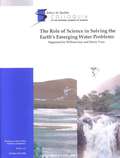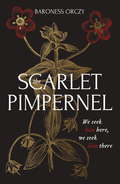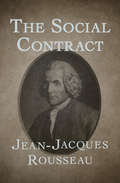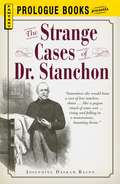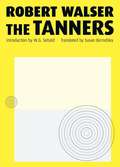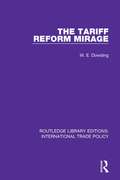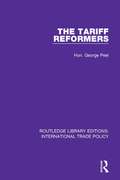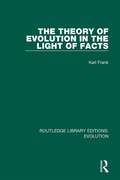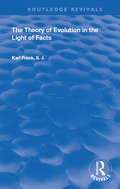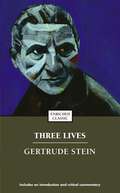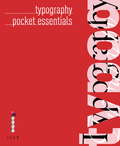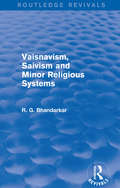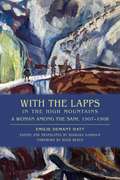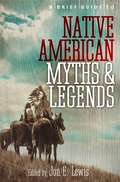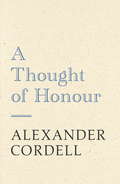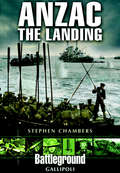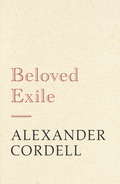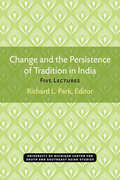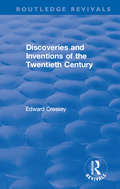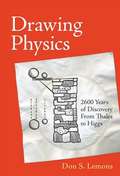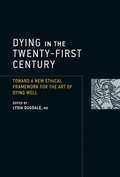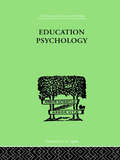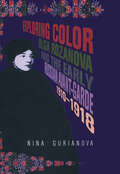- Table View
- List View
The Role of Science in Solving the Earth's Emerging Water Problems
by M. SacklerThe National Academies Press (NAP)--publisher for the National Academies--publishes more than 200 books a year offering the most authoritative views, definitive information, and groundbreaking recommendations on a wide range of topics in science, engineering, and health. Our books are unique in that they are authored by the nation's leading experts in every scientific field.
The Scarlet Pimpernel: Large Print (The Psammead Ser. #Vol. 1)
by Baroness OrczyBaroness Orczy's classic tale of adventure during the French Revolution. Also available as an unabridged audiobook, read by Julian Rhind-Tutt.Paris, 1792. The Terror has begun. Every day, scores of the French nobility are delivered to the guillotine. Trapped in the capital, they have no way of escape. But rumours abound of a league of young English gentlemen who are risking their lives to spirit French aristocrats away to safety across the Channel. Led by a man known only as the 'Scarlet Pimpernel', they leave no trace behind them save a single note. Determined to stop them, ruthless spymaster Chauvelin travels to England and embarks on a quest to uncover the identity of their leader, forcing the Scarlet Pimpernel and his men to summon all their courage and wits to evade capture and stay alive.PRAISE FOR THE SCARLET PIMPERNEL"Anyone who feels that their outward manner is but a travesty of their inner self can hardly fail to respond to THE SCARLET PIMPERNEL" - Independent"The Baroness Orczy invented the "masked avenger" genre of fiction - the swashbuckling hero of dual identity. Her progeny include Zorro, Superman, The Lone Ranger and many others." - Audiofile Magazine
The Social Contract: Or, The Principles Of Political Rights (World Classics Ser.)
by Jean-Jacques RousseauThe eighteenth-century philosopher&’s landmark treatise against monarchy that inspired the French and American Revolutions. &“Man is born free, and everywhere he is in chains.&” With these stirring words, Jean-Jacques Rousseau begins The Social Contract—the first shot in a battle of ideas that would set the stage for the American War of Independence and the French Revolution. In the feverish days of the Enlightenment, Rousseau took aim squarely at the all-powerful French monarchy, proclaiming that no despot, no matter how powerful, had the right to terrorize his people. He laid out a plan for a new kind of government—an idea that was radical then, and remains so now. The Social Contract is a landmark document from a fascinating period in world history and an invaluable guide to the foundations of modern democracy. This ebook has been professionally proofread to ensure accuracy and readability on all devices.
The Strange Cases of Dr. Stanchon
by Josephine Daskam BaconClairvoyant dreams, ghosts, murder, and intrigue abound in this short story collection! Dr. Stanchon might be a brilliant diagnostician, but the oddity of his cases more often involves the paranormal undercurrents of late nineteenth-century New York than curious illnesses. Whether he’s counseling his patients to break free of their compulsions, keeping family secrets, or tending to his haunted house and its ill-fated tenants, Dr. Stanchon always seems to be in the middle of something mere science just can’t explain!
The Tanners
by W. G. Sebald Susan Bernofsky Robert Walser"The Tanners is a contender for Funniest Book of the Year."--The Village Voice The Tanners, Robert Walser's amazing 1907 novel of twenty chapters, is now presented in English for the very first time, by the award-winning translator Susan Bernofsky. Three brothers and a sister comprise the Tanner family--Simon, Kaspar, Klaus, and Hedwig: their wanderings, meetings, separations, quarrels, romances, employment and lack of employment over the course of a year or two are the threads from which Walser weaves his airy, strange and brightly gorgeous fabric. "Walser's lightness is lighter than light," as Tom Whalen said in Bookforum: "buoyant up to and beyond belief, terrifyingly light." Robert Walser--admired greatly by Kafka, Musil, and Walter Benjamin--is a radiantly original author. He has been acclaimed "unforgettable, heart-rending" (J.M. Coetzee), "a bewitched genius" (Newsweek), and "a major, truly wonderful, heart-breaking writer" (Susan Sontag). Considering Walser's "perfect and serene oddity," Michael Hofmann in The London Review of Books remarked on the "Buster Keaton-like indomitably sad cheerfulness [that is] most hilariously disturbing." The Los Angeles Times called him "the dreamy confectionary snowflake of German language fiction. He also might be the single most underrated writer of the 20th century....The gait of his language is quieter than a kitten's." "A clairvoyant of the small" W. G. Sebald calls Robert Walser, one of his favorite writers in the world, in his acutely beautiful, personal, and long introduction, studded with his signature use of photographs.
The Tariff Reform Mirage (Routledge Library Editions: International Trade Policy #26)
by W.E. DowdingThis book, first published in 1913, records the ten years’ history of the Tariff Reform movement. Using the published declarations of both sides of the argument – the Tariff Reformers on one side, Free Traders on the other – the author provides the definitive account of Tariff reform up to the crisis of 1913.
The Tariff Reformers (Routledge Library Editions: International Trade Policy #27)
by Hon. George PeelThis book, first published in 1913, examines in detail the Tariff Reform crisis of January 1913. The sudden abandonment of decades of established policy was one of the most surprising events in British domestic politics.
The Theory of Evolution in the Light of Facts (Routledge Library Editions: Evolution #3)
by Charles T. DrueryOriginally published in 1913, The Theory of Evolution in the Light of Facts examines the theory of Descent; the book is a time capsule of information, providing a record of the explorations into Darwinian theory during the first half of the 20th century. The book examines the contradictions which arose between technical work of the period and the assumptions surrounding the theory of evolution. The book aims to address that which is considered ‘certain’ or ‘probable’ from postulation in order to explain and clearly define the theory of evolution. It does this through hypothesising on the development of animals and plants using the systems of Darwin and Lamarck. This book will be of interest to anthropologists and historians of natural science alike.
The Theory of Evolution in the Light of Facts (Routledge Revivals)
by Karl FrankPublished in 1913: The object of the present work is to throw some light on the theory of Descent. Among many of the students of nature of the present day we perceive that greater and greater contradictions arise between the actual results of their technical work and that which they put forward as ‘postulates’ of the theory of Evolution.
Three Lives: Stories Of The Good Anna, Melanctha And The Gentle Lena (Enriched Classics)
by Gertrude SteinThe first published work of fiction by legendary author and poet Gertrude Stein, Three Lives is a collection of two short stories and a novella focusing on the bleak existence that faced immigrant and minority women in turn-of-the-century America.Each impoverished woman must labor as a domestic worker to survive, and all three protagonists have their own tales of hardship. "The Good Anna" tells the story of a young German servant who must decide between loyalty to her employer and love. In "The Gentle Lena," another German servant girl marries the wrong man, and finds herself trapped as a wife and mother. And the introspective "Melanctha" examines the tragic life of a mulatto woman and those she loved.Pocket Books' Enriched Classics present the great works of world literature enriched for the contemporary reader. This edition of Three Lives has been prepared by Brenda Wineapple, professor of Modern Literary and Historical Studies at Union College. It includes her introduction, a selection of critical excerpts, and suggestions for further reading, as well as a unique visual essay of period illustrations and photographs.
Typography: Typography (Pocket Essentials Ser.)
by Graham Davis'Typography' opens with an overview of the history of the art, before going on to introduce the key principles and techniques of effective typography. A full introduction of the most useful and important fonts completes the book, allowing you to choose the right one every time. With this handy primer, anyone can master the basic principles of type layout and create pages that are easy on the eye and captivate the reader.
Vaisnavism, Saivism and Minor Religious Systems: Aus: Grundriss Der Indo-arischen Philologie Und Altertumskunde, Bd. 3. H. 6 (Routledge Revivals #3, 6)
by R G BhandarkarBhandarkar’s Vaisnavism, Saivism and Minor Religious Systems, first published in 1913, explores the origins of Vaishnavism by examining its sources of religion, aspects of the Mahabharata, and the Cult of Rama. Bhandarkar also discusses Saivism by exploring its origin and development. This text is ideal for students of theology.
With the Lapps in the High Mountains
by Emilie Demant HattWith the Lapps in the High Mountains is an entrancing true account, a classic of travel literature, and a work that deserves wider recognition as an early contribution to ethnographic writing. Published in 1913 and available here in its first English translation, it is the narrative of Emilie Demant Hatts nine-month stay in the tent of a Sami family in northern Sweden in 1907 8 and her participation in a dramatic reindeer migration over snow-packed mountains to Norway with another Sami community in 1908. A single woman in her thirties, Demant Hatt immersed herself in the Sami language and culture. She writes vividly of daily life, womens work, childrens play, and the care of reindeer herds in Lapland a century ago. While still an art student in Copenhagen in 1904, Demant Hatt had taken a vacation trip to northern Sweden, where she chanced to meet Sami wolf hunter Johan Turi. His dream of writing a book about his people sparked her interest in the culture, and she began to study the Sami language at the University of Copenhagen. Though not formally trained as an ethnographer, she had an eye for detail. The journals, photographs, sketches, and paintings she made during her travels with the Sami enriched her eventual book, and in With the Lapps in the High Mountains she memorably portrays people, dogs, reindeer, and the beauty of the landscape above the Arctic Circle. This English-language edition also includes photographs by Demant Hatt, an introduction by translator Barbara Sjoholm, and a foreword by Hugh Beach, author of A Year in Lapland: Guest of the Reindeer Herders.
A Brief Guide to Native American Myths and Legends: With a new introduction and commentary by Jon E. Lewis
by Lewis SpenceIn this brilliant reworking of Lewis Spence's seminal Myths and Legends of the North American Indians, Jon E. Lewis puts the work in context with an extensive new introductory essay and additional commentary throughout the book on the history of Native Americans, their language and lifestyle, culture and religion/mythology. He includes examples of myths from tribes omitted by Spence, a guide to tribes and their myths by region, a basic Lakota (Sioux) glossary, guides to key pronunciations and a bibliography.
A Brief Guide to Native American Myths and Legends: With a new introduction and commentary by Jon E. Lewis (Brief Histories)
by Lewis SpenceIn this brilliant reworking of Lewis Spence's seminal Myths and Legends of the North American Indians, Jon E. Lewis puts the work in context with an extensive new introductory essay and additional commentary throughout the book on the history of Native Americans, their language and lifestyle, culture and religion/mythology. He includes examples of myths from tribes omitted by Spence, a guide to tribes and their myths by region, a basic Lakota (Sioux) glossary, guides to key pronunciations and a bibliography.
A History of the World in 100 Weapons
by Chris McnabIt's a truism to say that history is written by the winners. But what is it about the winners that make them so powerful? In this enlightening new book, Chris McNab searches for answers to this question and much more, telling the story of the history of the world through the lens of the weapons used over time.Arranged by age, McNab details 100 weapons of history in a highly-illustrated format. Among these 100 weapons: * Roman gladius that helped establish the Roman Empire * Japanese Katana, or Samurai sword * English longbow, used to defeat the French at the battle of Agincourt * Maxim gun * Flying Fortress of World War II - the epitome of US military superiority * bomb on Hiroshima that made a weapon the ultimate deterrent * AK-47 rifle.A History of the World in 100 Weapons presents each weapon in full detail, exploring the how and why of the weapon's development, the times from which it emerged, how it was used in battle and by whom, and to what extent and impact. details of how and why each weapon was invented, the times they emerged from, how they were used in battle.Drawing on stories of famous battles, wars and leaders associated with each weapon, McNab presents a vivid history of the weapons themselves and their context in the development of world history.
A Thought of Honour
by Alexander CordellJohn Macmasters is an expert in the highly specialised skill of defusing explosives. his is the most nerve-racking job of them all - face to face with the possibility of a sudden and violent death. But in times of war new weapons must be tested. Macmasters' job is dangerous enough but he has something else to battle against too. His love for Loetia has made him intensely vulnerable. Suddenly he finds himself exposed to the ravages of fear, the enemy within. First published in 1954, A Thought of Honour was the first book in Alexander Cordell's highly prolific and successful career.
Anzac–The Landing: Gallipoli (Battleground Gallipoli)
by Stephen ChambersThe Anzac legend was born on the shores of Gallipoli during the historic morning of 25th April 1915. Landing on a hostile beach, under the cover of darkness, the Anzacs moved inland rapidly, but the response of the Ottoman forces was equally quick. The outcome of the campaign was arguably sealed during the first day, when the door for an Anzac victory was closed. With the order to dig, dig, dig and to stick it out, a stalemate was secured from the clutches of almost total disaster. After the Australians and New Zealanders received their baptism of fire, they became a stubborn thorn in the sides of the Ottoman army. Futilely after eight grueling months of fighting, the campaign came to an end with the complete evacuation of the Gallipoli Peninsula.Failure did not mar the actions and sacrifice of the Anzacs who bestowed a powerful legacy, as well as being a landmark in the birth of modern Turkey. Almost a century later, with all the veterans now sadly gone, their legacy still survives in Anzac Day and with the ever increasing numbers of pilgrims who visit the battlefield today.This attractive and well-written book will serve as either a handy guide or concise history (or both).
Beloved Exile
by Alexander CordellIestyn Mortymer, captured during the chartist Rebellion, is tried at the Monmouth Assizes and sentenced to twenty-one years transportation for crimes against Her Imperial Majesty Queen Victoria. Torn from his young wife Mari, he is exiled to Afghanistan - a country as violated and outraged as his native Wales. On all sides Iestyn witnesses signs of increasing hostility towards the English, and of the crumbling edifice of the Empire. Involved in the appalling 'Afghan Promenade' that cost the British army 17,000 lives, caught up by intrigue, murder and deadly deception, he cannot escape the fact that this is a time when every white face in the country is dubbed an Unbeliever, every redcoat a potential target of violence. Yet, despite everything, there is another escape that he is determined to make. Back to Wales... An epic blend of history and fiction, a swirling canvas of politics, war, servitude and passion, BELOVED EXILE marks the glorious culmination of Alexander Cordell's Welsh sagas.
Change and the Persistence of Tradition in India: Five Lectures (Michigan Papers On South And Southeast Asia)
by Richard L. ParkThe lectures presented in this volume were given during the summer of 1970 under the sponsorship of the CIC Summer Program on South Asia and the Center for South and Southeast Asian Studies of the University of Michigan. It should be recognized that these essays appear in revised lecture form, and not as fully polished scholarly papers. They carry nevertheless the authority—and no little verve—of experienced scholars concerned with both the traditions and the changes so characteristic of modern India. [v]
Discoveries and Inventions of the Twentieth Century (Routledge Revivals)
by Edward CresseyThe book is written for those, young and old, who wish to have a non-technical account of the great scientific and material triumphs which man has achieved and is achieving in their own day; and it seemed desirable to give first place to those theories, facts, and accomplishments which are now exercising the greatest influence upon human life. For science exists not so much to tickle the intelligences of the few as to brighten the lot of the many.
Drawing Physics: 2,600 Years of Discovery From Thales to Higgs
by Don S. LemonsHumans have been trying to understand the physical universe since antiquity. Aristotle had one vision (the realm of the celestial spheres is perfect), and Einstein another (all motion is relativistic). More often than not, these different understandings begin with a simple drawing, a pre-mathematical picture of reality. Such drawings are a humble but effective tool of the physicist's craft, part of the tradition of thinking, teaching, and learning passed down through the centuries. This book uses drawings to help explain fifty-one key ideas of physics accessibly and engagingly. Don Lemons, a professor of physics and author of several physics books, pairs short, elegantly written essays with simple drawings that together convey important concepts from the history of physical science.Lemons proceeds chronologically, beginning with Thales' discovery of triangulation, the Pythagorean monocord, and Archimedes' explanation of balance. He continues through Leonardo's description of "earthshine" (the ghostly glow between the horns of a crescent moon), Kepler's laws of planetary motion, and Newton's cradle (suspended steel balls demonstrating by their collisions that for every action there is always an equal and opposite reaction). Reaching the twentieth and twenty-first centuries, Lemons explains the photoelectric effect, the hydrogen atom, general relativity, the global greenhouse effect, Higgs boson, and more. The essays place the science of the drawings in historical context -- describing, for example, Galileo's conflict with the Roman Catholic Church over his teaching that the sun is the center of the universe, the link between the discovery of electrical phenomena and the romanticism of William Wordsworth, and the shadow cast by the Great War over Einstein's discovery of relativity. Readers of Drawing Physics with little background in mathematics or physics will say, "Now I see, and now I understand."
Dying in the Twenty-First Century
by Lydia DugdaleMost of us are generally ill-equipped for dying. Today, we neither see death nor prepare for it. But this has not always been the case. In the early fifteenth century, the Roman Catholic Church published the Ars moriendi texts, which established prayers and practices for an art of dying. In the twenty-first century, physicians rely on procedures and protocols for the efficient management of hospitalized patients. How can we recapture an art of dying that can facilitate our dying well? In this book, physicians, philosophers, and theologians attempt to articulate a bioethical framework for dying well in a secularized, diverse society. Contributors discuss such topics as the acceptance of human finitude; the role of hospice and palliative medicine; spiritual preparation for death; and the relationship between community, and individual autonomy. They also consider special cases, including children, elderly patients with dementia, and death in the early years of the AIDS epidemic, when doctors could do little more than accompany their patients in humble solidarity.These chapters make the case for a robust bioethics -- one that could foster both the contemplation of finitude and the cultivation of community that would be necessary for a contemporary art of dying well. ContributorsJeffrey P. Bishop, Lisa Sowle Cahill, Daniel Callahan, Farr A. Curlin, Lydia S. Dugdale, Michelle Harrington, John Lantos, Stephen R. Latham, M. Therese Lysaught, Autumn Alcott Ridenour, Peter A. Selwyn, Daniel Sulmasy
Education Psychology: BRIEFER COURSE
by E.L. ThorndikeThis is Volume VIII of thirty-two in a series on Developmental Psychology. Originally published in 1923, the author wites that our knowledge of human instincts and capacities, of the processes of learning and remembering, of mental work and fatigue, and of individual differences and their causes has been much increased in the past score of years. This Briefer Course represents a simpler treatment of the more fundamental subject matter of these volumes, organized as a text-book in Educational Psychology for students in colleges and schools.
Exploring Color: Olga Rozanova and the Early Russian Avant-Garde 1910-1918
by Nina GurianovaThis is an examination of the paintings, books, poetry and theoretical work of Russian avant-garde artist, Olga Rozanova. The text assesses Rozanova's life and work, aiming to recreate the spirit of the counterculture milieu that contributed to the transformation of 20th-century art.
